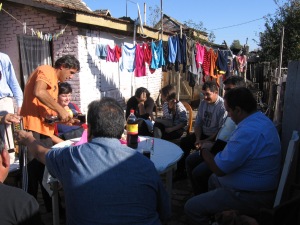A few days ago, police conducted a raid in a Roma community in Greece, discovering a little white girl with her two dark-skinned parents. Although this story has been scattered over various news sources, click here for the story if you are unaware of the details.
Judging from the numerous angles the news sources have taken, this story triggered a multi-layered response: it has played into the ongoing international fascination with the Roma, refueled the centuries old myth that “Gypsies steal children,” revived hope for those who agonize over their own missing children, and reinforced Roma prejudice and suspicion that lurks both explicitly and implicitly in Europe.
I must first point out that perhaps a crime was indeed committed, and if this is so, the couple should be held accountable. But many facts are obscured and confusing about the story and it is hard to understand what has actually happened. Unfortunately, simply because it involves a Roma couple, it is not just an isolated case investigating a possible kidnapping. Rather, all Roma are put on a prosecutor’s witness stand—a layered Pandora’s box with sinister overtones.
Here are some implicit implications in the media messages and the action of the law enforcement:
1. Gypsies, who are often dark skinned, should not have light skinned children. If they do have a light-skinned child, they must have done something wrong. Already, other countries are acting on this assumption: Blond Girl, 7, removed from Dublin Roma family.
In what other cultural context would it be assumed that because an offspring looks different than the parents, the parents must have abducted the child? Is it not possible for a Roma family to adopt a non-Roma child?
2. The little girl, Maria, has been dubbed the “blond angel.” Even this terminology sets up a dichotomy between the whiteness—and therefore goodness—of the girl, as opposed to her dark-skinned Gypsy parents.
3. The sensationalism of this story obscures the real issues. There are, in fact, serious issues of child trafficking, crime rings, and prostitution that need to be investigated and prosecuted. In fact, a Croatian Roma crime ring involving children was just recently discovered. Of course, such crimes exist in every context—but few other cultures have to bear the weight of guilt from one person’s illegal actions as do the Roma.
The Roma community in Greece expressed fear and anger when the police searched the entire community: “There is no buying and selling of children here,” Christos Lioupis, a man who lives in the Roma community but is not of them, told the Associated Press. “The other Roma are not to blame. These are family people. After this event, the police have been searching everyone. Isn’t this racist?”
We know there is an insidious proliferation of human trafficking found throughout the globe in numerous different cultures and contexts, but many of us do not realize the extent of a rampant Anti-Gypsyism, spread throughout the European continent. While I do not want to trivialize, reduce, or dehumanize little Maria’s fate to merely “issues,” it is also important to note that this case unintentionally brings both of these serious issues to light.
The media has an important role to play in how the general public understands and responds to this situation. The European Roma Rights Center just issued a plea for responsible reporting, restraint, and a full examination of all facts before assumptions are made, citing current example of skinheads in Serbia trying to take a two year old boy away from a Roma couple since he “wasn’t as dark as his parents.” ERRC states: “Criminality is not related to ethnicity. Roma children are, however, much more likely to be put into state care, trapped in segregated education, and forcibly evicted from their homes. These are the stories that don’t make it to the front page.”
This story is important—if there has been a kidnapping, it needs to be rectified and brought to justice. I fervently hope that the couple is telling the truth and the child was given to them in good faith. But the story cannot be separated from the wider historical and cultural context—a context which 10-12 million Roma in Europe face each day.
Click Here for a great perspective on the situation from a Roma writer, Oksana Marafioti, who wrote the excellent book American Gypsy: A Memoir



